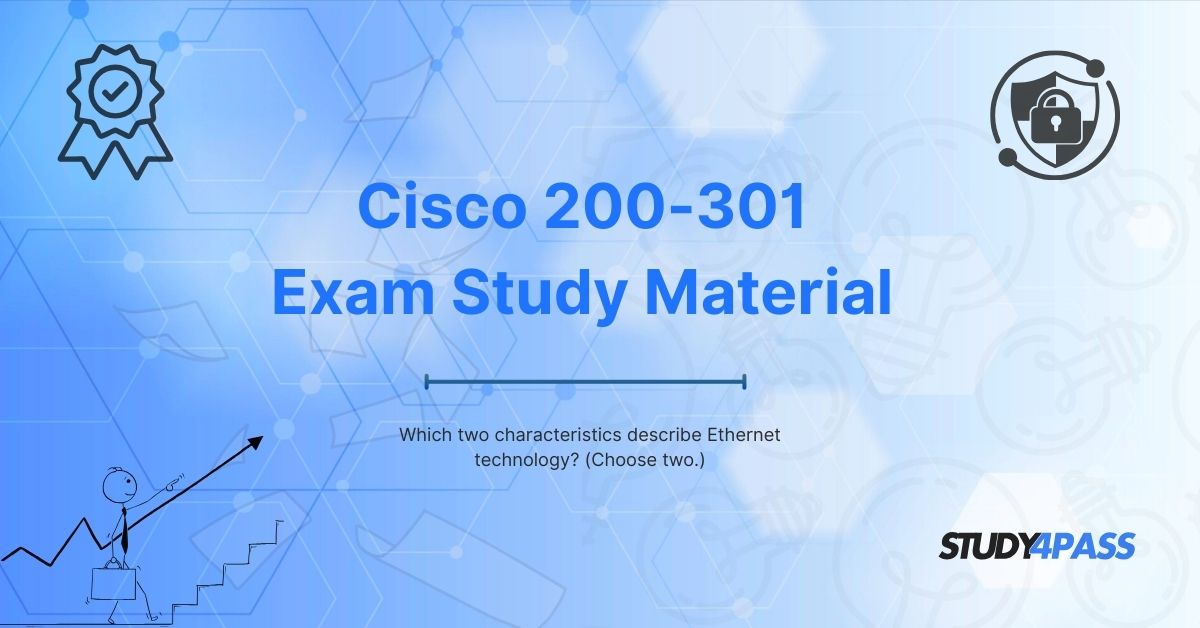Introduction
Ethernet is one of the most widely used networking technologies in the world, forming the backbone of local area networks (LANs) and wide area networks (WANs). For aspiring network professionals pursuing certifications like CCNA, CCDA, CCENT, CCNA Security, or CCNA Wireless, understanding Ethernet technology is crucial.
This article explores two key characteristics of Ethernet technology and provides in-depth explanations to help you prepare for your exams. Additionally, we highly recommend Study4Pass as a reliable resource for Cisco certification study materials, including practice tests, exam prep practice test, and detailed guides.
What is Ethernet Technology?
Ethernet is a family of networking technologies used for wired communication in LANs and WANs. It was developed in the 1970s by Xerox, Intel, and DEC (Digital Equipment Corporation) and later standardized by the IEEE (Institute of Electrical and Electronics Engineers) under the IEEE 802.3 standard.
Ethernet defines how data is transmitted over physical media, including:
- Copper cables (e.g., Cat5e, Cat6, Cat6a)
- Fiber optic cables
- Wireless extensions (though traditionally wired)
Now, let’s discuss the two primary characteristics of Ethernet technology that are often tested in Cisco certification exams (200-301 CCNA, CCDA, CCENT, etc.).
Characteristic 1: Ethernet Uses CSMA/CD for Media Access Control
What is CSMA/CD?
CSMA/CD (Carrier Sense Multiple Access with Collision Detection) is a media access control method used in traditional Ethernet (half-duplex) networks. It helps devices share the same communication medium efficiently.
How CSMA/CD Works?
- Carrier Sense (CS) – A device checks if the network is idle before transmitting data.
- Multiple Access (MA) – Multiple devices share the same communication channel.
- Collision Detection (CD) – If two devices transmit simultaneously, a collision occurs. The devices detect the collision, stop transmission, and wait for a random backoff time before retrying.
Why is CSMA/CD Important?
- Prevents data collisions in shared networks.
- Ensures fair access to the transmission medium.
- Although modern Ethernet (full-duplex) no longer relies on CSMA/CD, understanding it is essential for legacy systems and exam purposes.
Exam Relevance
Questions in CCNA 200-301 may ask:
- "Which protocol helps Ethernet devices avoid collisions?"
- "What does CSMA/CD stand for?"
Study4Pass provides detailed explanations and practice questions on CSMA/CD, helping you master this concept for your exam.
Characteristic 2: Ethernet Supports Full-Duplex Communication
What is Full-Duplex Communication?
Full-duplex allows simultaneous two-way communication, meaning a device can send and receive data at the same time without collisions.
How Full-Duplex Works in Ethernet?
- Requires a dedicated connection (e.g., switch-to-device links).
- No collisions occur because transmit (Tx) and receive (Rx) channels are separate.
- Enables faster data transfer (e.g., Gigabit Ethernet, 10G Ethernet).
Half-Duplex vs. Full-Duplex
|
Feature |
Half-Duplex |
Full-Duplex |
|
Data Flow |
One direction at a time |
Simultaneous two-way |
|
Collisions |
Possible (CSMA/CD needed) |
Not possible |
|
Performance |
Slower |
Faster |
|
Usage |
Legacy hubs |
Modern switches |
Exam Relevance
CCNA exams may ask:
- "Which Ethernet mode allows simultaneous sending and receiving of data?"
- "What is the advantage of full-duplex over half-duplex?"
Study4Pass offers real exam-like questions on Ethernet duplex settings, ensuring you’re well-prepared.
Additional Key Features of Ethernet
While the above two characteristics are critical, Ethernet also has other notable features:
1. Scalability (Speed Variations)
Ethernet supports multiple speeds:
- 10 Mbps (Traditional Ethernet)
- 100 Mbps (Fast Ethernet)
- 1 Gbps (Gigabit Ethernet)
- 10 Gbps, 40 Gbps, 100 Gbps (High-Speed Ethernet)
2. Frame-Based Communication
Ethernet transmits data in frames, which include:
- Source and destination MAC addresses
- Payload (data)
- Error-checking (FCS - Frame Check Sequence)
3. Backward Compatibility
Modern Ethernet devices support older standards, ensuring seamless integration.
Why Choose Study4Pass for CCNA, CCDA, and CCENT Preparation?
Preparing for Cisco certifications (CCNA 200-301, CCDA, CCENT, CCNA Security, CCNA Wireless) requires high-quality study materials. Study4Pass is a trusted platform offering:
- Latest Exam Prep Practice Test – Updated questions matching current exam patterns.
- Detailed Explanations – Clear breakdowns of complex topics.
- Practice Tests – Simulate real exam conditions.
- Expert Guidance – Tips from certified professionals.
By using Study4Pass, you can:
- Save time with structured study plans.
- Boost confidence with high-accuracy practice tests.
- Pass exams faster with proven strategies.
Visit Study4Pass today and accelerate your Cisco certification journey!
Conclusion
Ethernet technology remains fundamental in networking, and understanding its key characteristics—CSMA/CD for collision handling and full-duplex communication for efficient data transfer—is essential for CCNA, CCDA, CCENT, and other Cisco certifications.
For the best exam preparation, rely on Study4Pass for authentic study materials, practice tests, and expert guidance. Start your journey toward becoming a certified networking professional today!
Special Discount: Offer Valid For Limited Time “200-301 Free Study Material”
Actual Exam Questions For Cisco's 200-301 Certification
Sample Questions For Cisco 200-301 Mock Exam
1. Which two characteristics describe Ethernet technology? (Choose two.)
A) Uses token-passing for media access
B) Operates at the Data Link and Physical layers
C) Supports only wired connections
D) Commonly used in WANs
2. Which two are true about Ethernet technology? (Choose two.)
A) Defined by IEEE 802.3 standards
B) Exclusively used in wireless networks
C) Uses CSMA/CD for collision detection (in older versions)
D) Functions only at the Network layer
3. Which two features are associated with Ethernet? (Choose two.)
A) Guarantees deterministic data transmission
B) Typically uses MAC addresses for communication
C) Operates only in full-duplex mode
D) Supports both wired (copper/fiber) and wireless media
4. Which two statements describe Ethernet? (Choose two.)
A) Primarily designed for wide area networks (WANs)
B) Uses frames for data encapsulation
C) Requires a dedicated circuit for communication
D) Can operate at speeds of 10 Mbps, 100 Mbps, 1 Gbps, and higher
5. Which two are key characteristics of Ethernet? (Choose two.)
A) Relies on a centralized controller for data transmission
B) Supports broadcast and unicast communication
C) Functions only in half-duplex mode
D) Commonly used in LANs


